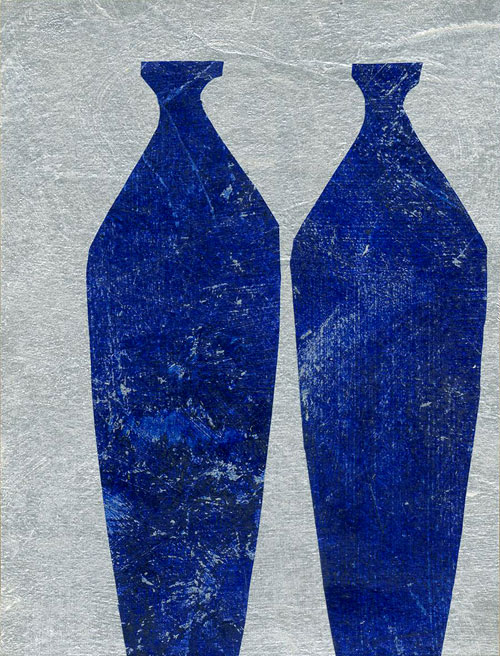
Something Old, Something New © Jan L. Richardson
While I was at St. John’s University in Minnesota last week, I made a couple of visits to the Hill Museum and Manuscript Library (known in those parts as the HMML). The Benedictine monks of St. John’s founded the HMML to preserve the medieval manuscript heritage of Europe, Africa, and the Middle East, and it’s always a favorite destination for a girl with a blog called The Painted Prayerbook. This summer the HMML is home to a tasty exhibition of original folios from The Saint John’s Bible, the first Bible to be written and illustrated entirely by hand in more than five hundred years. Featuring the Wisdom Books section of The St. John’s Bible, the exhibition marks the completion of five of the planned seven volumes of this contemporary manuscript. By the time that Donald Jackson and his team of scribes and artists complete their lavish, monumental work, the Bible will have absorbed about ten years of their lives.
A group was touring the exhibition during one of my visits to the museum. As I took in the folios, with the gold dancing on their pages, I tuned an ear to the comments that the group’s HMML guide offered. After her presentation, she fielded a number of questions. “Why,” one person asked, “in this age of high-quality printing technology, would someone spend the time to create an entire Bible by hand?” As the guide responded, she spoke about the value of recovering ancient practices of bookmaking as a sacred art, and of the beauty that emerges in fashioning something by hand. She pointed out that contemporary technology has played a significant role in The Saint John’s Bible; a designer used a computer to plan the entire layout of the pages before the team began to lay the first strokes of ink, paint, and gold leaf on the vellum sheets.
It’s a treasure that draws from what is old and what is new.
We hear about such treasures in this week’s gospel lection, Matthew 13.31-33, 44-52. Jesus, who is in a parable-telling mood at this point in the gospel, offers a series of images that describe what the kingdom of heaven is like. He speaks of a mustard seed that grows into a tree, yeast that a woman mixes with flour, a man who discovers treasure hidden in a field, a merchant who finds a pearl of great value, and a net filled with fish. Jesus closes the litany of images by saying, “Therefore every scribe who has been trained for the kingdom of heaven is like the master of a household who brings out of his treasure what is new and what is old.”
The scribe about whom Jesus speaks is a rather different sort of scribe than those who have been laboring over The Saint John’s Bible. Jesus’ scribe is one versed in Mosaic Law, a person who knows and draws from the wealth of the law and also recognizes new treasure when it appears. Yet the scribes of The Saints John’s Bible, and the pages they have created, embody what Jesus’ kingdom-images evoke. Each reminds us of how the holy, which so often seems hidden, emerges when we stretch ourselves into searching for it, seeking it, laboring toward it. The bakerwoman kneading in her kitchen, the man who sells all that he has to buy the field, the merchant who gives up everything to purchase the pearl of great price, the scribe trained for the kingdom of heaven, the householder who brings forth treasure old and new: each of these has given themselves, devoted themselves, to a particular process by which treasure emerges. They know what skills it takes, what vision, what devotion. Each trained in their particular art, they possess in their bones the knowledge that tells them what ingredient to use, what tools old or new to employ, what treasure lies before them.
Offering these images, Jesus recognizes there are things that are worth a long devotion; there is treasure worth giving ourselves to for a decade, a lifetime. Such treasure might not have a usefulness that is obvious, or readily grasped. In a world where technological shortcuts abound (and are useful at times, to be sure)—bread machines, metal detectors, faux pearls, computer printers—something happens when we take the long way around, when we hunt for the holy that often loves to hide in work that takes time, takes the development of skill, takes commitment, takes the long view.
I think of when I was first learning calligraphy a few years ago. There was no getting around the need for practice. Over weeks and months, as I covered page after page with ink, shaky lines steadily grew more sure, and awkwardness began to give way to art.
This type of long laboring and searching reveals something about our own selves. Submitting ourselves to a process of practicing brings secret parts of ourselves to the surface; it draws us out and unhides us, and the holy that dwells within us. “The kingdom of God is among you,” Jesus says in Luke 17.21. Among us, and meant to be uncovered, to become visible, to offer sustenance and grace for the life of the world. Like bread. Trees. Pearls. Pages. Treasure born of what is old and what is new.
What treasure have you found, or long to find, in the hidden places of your life? What searching, what seeking might God be challenging you toward, to uncover what’s been buried? Is there anything in your life that invites you to encounter the holy in a process that takes time, practice, skill, devotion? What of yourself do you find in that, and what do you find of God?
May this week bring a hidden gift your way. Blessings.
[To use the “Something Old, Something New” image, please visit this page at janrichardsonimages.com. Your use of janrichardsonimages.com helps make the ministry of The Painted Prayerbook possible. Thank you!]












Leave a Reply